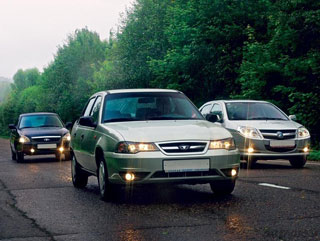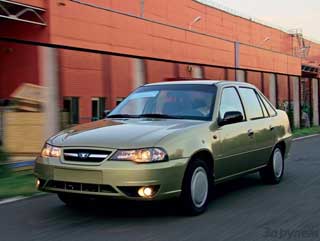Test Drive Daewoo Nexia (Kletn) 1995 - NV Sedan
Dynasty
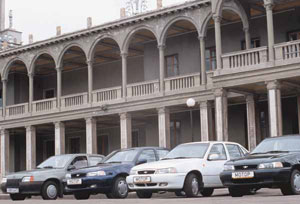 About the Korean Daewoo Corporation and its Nexia models in Russia know, probably, everything. The fact that Nexia is produced in Uzbekistan - abroad, they know almost everything. And about the fact that Nexia is also collected in Rostov - in Russia - almost no one knows.
About the Korean Daewoo Corporation and its Nexia models in Russia know, probably, everything. The fact that Nexia is produced in Uzbekistan - abroad, they know almost everything. And about the fact that Nexia is also collected in Rostov - in Russia - almost no one knows. We decided to restore justice and took on the test three cars Daewoo Nexia - Korean, Uzbek and Rostov production. And added to them the progenitor - Opel Kadett.
How it all began
Daewoo Nexia - Opel Kadett ancestor at one time was recognized as one of the most popular European cars. Usually, the Opel models are held in production for quite a long time, for example, OMEGA has been produced since 1986, and Vectra since 1988 - to this day and only with minor changes.
Kadett has broken tradition. It was designed in 1984-1985, and his release time had to for the period of cardinal shift of views on the aesthetics of automotive bodies and the development of new directions in design. In addition, it refers to the Golf class, where the tone specifies the VW, which has released the grown Golf-III, so in 1992, having launched on the conveyor of only 5 years, Kadett was replaced by a more modern Opel Astra. But only in European factories.
Adam Opel AG, as is known, belongs to General Motors Corporation. She also belonged to the half of the Daewoo shares. By putting the production of Kadett in Europe, GM began his release and in South Korea. In 1991, Daewoo gained independence from the overseas partner, but did not give up still quite a modern and competitive machine. Thanks to the German origin, good ergonomics and the incomplete operational characteristics of Kadett, collected in Korea under the Daewoo Le Man's brand, was quite successfully sold within the country, and was exported to Europe and America.
Later, the car was renamed Daewoo Racer, with him Koreans managed to take a niche of the European market, which Kadett released. In 1994, restyling and replaced the name, this time on Nexia. In the same year, the car began to supply to Russia.
Here, Nexia has a rather quickly reputation of a reliable, unpretentious and sufficiently comfortable car, consumer qualities of which fully complied with the conditions of operation in the CIS. On the eve of the termination of the release of this model in Korea (stopped in 1997), the hosts showed interest in cooperation and agreed to move production first to Uzbekistan, and then to Russia.
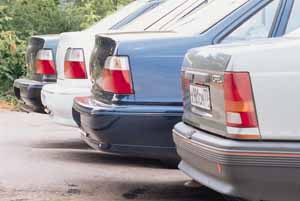 Scrabble will help us
Scrabble will help us After the decay of the superpower and independence, most of the former Union republics, almost all Central Asian states were forced to urgently create their own industry and mechanical engineering. The Government of Uzbekistan at that time put forward three priority areas: oil production and refining, gold mining and the creation of the national automotive industry. The interests of the country and Daewoo crossed. For the construction of the auto plant, a joint venture was created, in which the parties were invested by 50% of capital.
The plant was based on the fact that cars will be done using no more than 50% of imported parts. Of course, it is not immediately, but as the adjacent production is created - the aggregate, paintwork, radiator, etc. The motor was not planned, but now there are prerequisites for its creation, and perhaps over time from imports will refuse at all.
The first car came down from the conveyor on July 19, 1996. Then he was 30% from the details of local production. Now, a year later, the share of Uzbek components is 40% and grows every day. We produce three models - Tico, Nexia and Damas. The design capacity of the plant - 200,000 cars per year, on the first year it is planned to release no more than 100,000, that the management explains the policies of the phased development of the market and the reluctance to keep unsold cars on the drives.
Soviet Own Pride
A businessmen from the Financial and Industrial Group Doninvest went on a different way. Without noise and excitement, without public investment, capitalistically modestly on the basis of the Rostov Plant Red Aksai was born a small car mooring enterprise of a strife type. The bike did not invent, developing their own mutants, did not chase the prestige of possessing their own brand, they simply sent off the world's cooperation worldwide.
At first, no one responded, did not believe the leaders of the world automotive industry in the seriousness of the intentions of a small Rostov company. Finally, through third hands, three hundred sets of various American cars were purchased. A story is silent about the initial purpose of these sets, but most likely it was Kit-Car - a sort of piece of details do it yourself. They themselves did. And successfully sold. Thus, the Red Aksai acquired the status of the automobile plant, and some large firms began to look at it.
The greatest efficiency was shown, of course, Koreans, the same Daewoo Corporation. Money did not help with money, and the Rostov team did not insist, but they were offered to supply Nexia and Espero models machine collectors. What is machine collector, readers of our magazine know from the report about the corporation of Elaz-GM (Motor 6 (14).
In 1996, a conveyor came to replace a stripping assembly. The volume of production has grown from 12 to 100 cars per day. To reduce the purchase price, increased the number of own installation operations. A year earlier, Axai had to build a car from all of the nine major units, now the machine collector crushed into twenty knots arrives from Korea and Romania. But the salon is still coming fully assembled.
Domestic components in Rostov machines are not used. There are such intentions, but the first attempt ended unsuccessfully - they wanted to put alloy wheels of local production, carried out all the tests, the Koreans gave good, but convinced the manufacturer to improve the appearance of the products failed. Maybe for the better.
In 1996, about 5 thousand cars were collected. All sold. Apparently, believing in the viability of the plant, Koreans this year discovered their representation there. Helps advice in the field of marketing and advertising, but the capital of the enterprise is still completely Russian. It is good, and not only from the point of view of the boom patriotism - there is complete freedom of maneuver.
Now Red Aksai is firmly on the legs and is actively expanding - a large automobile enterprise is built on the basis of the Taganrog Combine Plant.
It is planned that it will earn by the end of 1998, and the power of the conveyor will be 120,000 cars per year.
In addition to Nexia, Rostov is collected and the class model is higher - Espero. There are intentions to establish the assembly of completely new models of Daewoo - Lanos, Nubira and Leganza, which just showed in Europe.
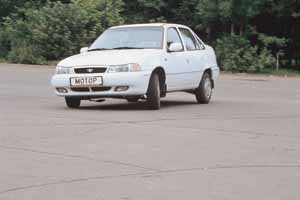 Find ten differences
Find ten differences So, Daewoo Nexia. The same car, but by different hands and in different technology. So, some differences can be. So we decided to compare cars done in Korea, Uzbekistan, Rostov ....
Getting the Uzbek and Rostov Nexia did not make it possible. Some difficulties were with the Korean production machine - the issue is discontinued. But also found. Include in the rate of progenitor - Opel Kadett - It seemed so natural to us that we did this without thinking. And only then they realized that it would be difficult to compare. All Nexia new, almost without run, and Kadett - aged. But still decided to leave him - as a certain point of reference.
And now we have four cars. Kadett, of course, we learned right away, and where what Nexia was decided not to find out in advance. Externally, Daewoo cars differ from Opel not very much. Thanks to the more massive bumpers, Nexia looks larger and lower than Kadett. Non-minor alterations of the hood and grid of the radiator gave a more modern view with some oriental accent. But the loading opening of the trunk in the German car is much more convenient.
Koreans were fascinated by fashionable beveled rear lanterns, significantly narrowing the beak of the cover, which way to the huge luggage compartment it became impossible to place a large-sized object, and the far outstanding bumper does not allow close to approach the car, placing his swing or getting a spare wheel. In Kadett, the vertical line of the connector between the wings and the rear panel is the width of the opening only slightly less body width.
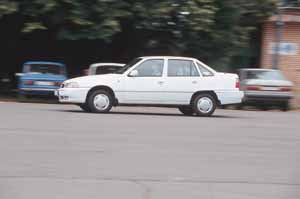 But it's time for the wheel. Started with Kadett. The car of 1988 release came from Germany two weeks before the test. On the speedometer 40.000 km, most likely it is the second round. Given the age of the car, the run-in began in a gentle mode. But quickly made sure that the engine and suspension in excellent condition, and the car is quite capable of withstanding increased loads.
But it's time for the wheel. Started with Kadett. The car of 1988 release came from Germany two weeks before the test. On the speedometer 40.000 km, most likely it is the second round. Given the age of the car, the run-in began in a gentle mode. But quickly made sure that the engine and suspension in excellent condition, and the car is quite capable of withstanding increased loads. The car is perfectly controlled, has quite decent dynamics and stability in turns. The carburetor engine is adjusted so clearly that with any intensity of pressing the gas pedal, the car accelerates without failures, confidently and stable. The engine is very elastic, you can move in the range of 20-80 km / h in the second or third gear to the choice, in the first case does not spinning the motor to the maximum, and in the second - without having stuck at a minimum.
The operation of the CAT - without complaints, the transmissions are included absolutely accurately.
For Kadett, there was a turn of the first car Daewoo. What? At that moment it was unknown. Salon, of course, is rich. Soften front panel circuits, devices are larger and read better, to the right and left of them are convenient keys to turn on fog light, alarm and rear window heating. The asymmetric central console is also lined in accordance with the modern fashion, but it is not different from the Kadett panel. Otherwise, the internal decoration of cars is almost identical, only Nexia has an adjustment of the stiffness of the front seats. And, of course, electrical windows and air conditioning. However, on Opel, their installation is also possible, we simply had a simple equipment on our test.
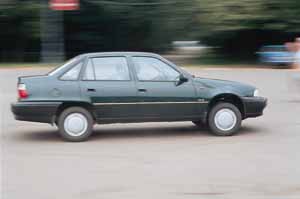 On the go Kadett and Nexia seemed the same, the same dynamic properties, the same maneuverability. The engine volume from Nexia on a glass is larger, there is a fuel injection, but the compression ratio is noticeably lower, and the horses under the hood did not increase. By the way, the power steering was installed on all Koreans, but the difference in the management between them and the German is not felt. Only the pendant from Nexia turned out to be a little softer, but we should not forget that Opel was nonsense.
On the go Kadett and Nexia seemed the same, the same dynamic properties, the same maneuverability. The engine volume from Nexia on a glass is larger, there is a fuel injection, but the compression ratio is noticeably lower, and the horses under the hood did not increase. By the way, the power steering was installed on all Koreans, but the difference in the management between them and the German is not felt. Only the pendant from Nexia turned out to be a little softer, but we should not forget that Opel was nonsense. We have transplanted from one Nexia to another, from time to time returning to Kadett - all the same reference point. So what? Never mind. The difference in the driving qualities of all four cars we did not find. Only on one machine, the clutch pedal seemed softer than on others. Then they found out that it was Nexia from Uzbekistan, she has a hydraulic clutch drive, and on other machines - a cable.
The only difference between Daewoo Nexia of different manufacturers, which we found is the color of bumpers. In Uzbek machines, they are unpainted, and Korean and Rostov correspond to the body color.
We did not rip off the upholstery, scratch the paint, search for non-crushed places on the internal panels, to compare the quality of the welds and the tightening of nuts.
First, no one would allow us, secondly, if something is wrong there, it will manifest itself in 5-10 thousand kilometers. And this is already a completely different test to which we may be back.
In the meantime, it remains only to greet the appearance on the Russian market of one model from two different manufacturers and hope that healthy competition between them will not allow to lower the quality bar, which will benefit the consumer.
Evgeny Romantsky
A source: Magog Motor [№8 / 1997]
Test Drives Daewoo Nexia (Kletn) 1995 - NV
Daewoo Nexia malfunctions (Kletn) 1995 - NV
Daewoo Nexia malfunctions: details| Nexia (Kletn) 1995 - NV | |
|---|---|
| Engine |  |
| Transmission |  |
| Management and suspension system |  |
| Brake system |  |
| Heated air and air conditioning |  |
| Start and Charging System |  |
| Electrical components and other |  |
| Body stability to corrosion |  |

_1995_-_nv_10.jpg)
_1995_-_nv_11.jpg)
_1995_-_nv_12.jpg)
_1995_-_nv_13.jpg)
_1995_-_nv_14.jpg)

